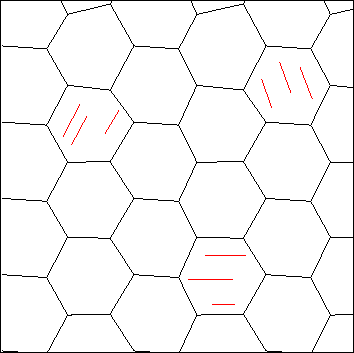




Next: EXAMPLES
Up: Berryman and Grechka: Random
Previous: INTRODUCTION
The technical aspects of the modeling approach follow the results
contained in Berryman (2005), and are summarized in Appendix A. The main idea is based on several
facts about polycrystals and the technical issues associated with
estimating their properties.
The first and most obvious issue with cracked materials is that,
in the vicinity of one crack, the effective elastic properties
will necessarily be anisotropic. Since by far the great majority of
effective medium and other upscaling methods for composite materials
have been designed for overall isotropic composites composed of isotropic
constituents, we necessarily must try something rather different for
cracked materials. It seems natural to suppose that the cracked medium
may be viewed as a collection of randomly oriented grains of various
sizes and orientations containing cracks. For the dilute case having
rather small crack densities, we could imagine that each grain has
only one crack per grain. But, as the crack density increases,
cracks may intersect with other cracks. In this case, we may have
multiple cracks and/or intersecting cracks in each grain.
The shape of the cracked grains is another possible variable within the model.
It is fairly common in the study of polycrystals to assume that the
grains are spherical (Olson and Avellaneda, 1992).
Since it is clear that it is not possible to
fill all of space with spheres of the same size, such a model requires
a further assumption that the grains come in a wide variety of sizes
down to the infinitesimal and that this happens in a way that does
fill all space. It seems clear that this type of model is artificial
in the sense that it applies to no real material, but it nevertheless
is a model that has been used extensively in effective medium theories and
generally seems to produce reasonable modeling results. Nevertheless, we
will avoid this approach here and consider instead an alternative
wherein we assume that the cracks come in clusters. A cluster might be
just one crack, or several cracks in close proximity. Then we assume
each cluster is sufficiently separated from the other crack clusters that
we can assign a center point to each cluster and then construct Voronoi
polyhedra by drawing planes midway between nearest neighbors so that
all of space is partitioned without leaving any holes.
Figure 1 illustrates one realization for this model random
polycrystal of cracked grains.
Fig1
Figure 1 Schematic illustrating the random polycrystals
of cracked grains model. Grains are assumed to fit tightly so there
is no misfit porosity, although there is some porosity due to the
cracks themselves.
The shapes of the grains are not necessarily the same, and the
symmetry axes of the grains (three examples shown) are
randomly oriented so the overall polycrystal is equiaxed
(statistically isotropic).
|
|  |

Various rigorous bounds are known for
polycrystals [Voigt (1928), Reuss (1929), Hashin-Shtrikman (1962b)],
and the commonly used
Voigt-Reuss-Hill estimate (arithmetic average of the Voigt and Reuss
bounds (Hill, 1952) is both well-known and well-established.
It is important to
note however that the Hashin-Shtrikman bounds are problematic for the
polycrystalline case because it is known that for composites
of anisotropic components the Voigt bound is achievable in certain
special cases (Milton, 2002). This fact is sufficient to invalidate the use of the Hashin-Shtrikman
bounds as a general method (since the upper HS bound is always
smaller than the Voigt bound, thus precluding the possibility of achieving
the Voigt bound in the cases where this is known to be an exact
result - IF the HS upper bound were valid). Thus, HS bounds must be
used cautiously,
if at all for anisotropic media, and with the understanding that there
are various implicit assumptions in the HS theory that may or may not
be satisfied in a given composite having anisotropic constituents
(Milton, 2002).
On the other hand, there are also general self-consistent estimators
available for these same anisotropic composites
(Willis, 1977, 1981; Berryman, 2005).
These self-consistent estimators actually do lie between the
Hashin-Shtrikman bounds, but -- since they are merely estimates of
the average behavior and not bounds in any sense -- they do not
suffer from the same questions concerning their validity as the HS
bounds themselves. These self-consistent estimates for polycrystals
have approximately the same theoretical significance as the
Voigt-Reuss-Hill estimates, and should therefore provide generally useful
quantitative measures of expected average elastic behavior of
polycrystals. We use both types of estimates (Voigt-Reuss-Hill and
self-consistent) here when we need values of effective bulk and shear
moduli: (1) we use the VRH approach as a means of estimating the effective
bulk and shear moduli that can be associated with the stiffness
matrices generated by the numerical methods and (2) we use the
self-consistent estimator as a means of quantifying the average
behavior associated with our predictions and/or fitted values for the
polycrystal model.
In the following examples, we find that the HS bounds are in fact much
too close together to be useful in explaining the range of behavior observed in
the numerical data considered here. However, the Voigt and Reuss
bounds do give very good estimates for the range in behavior, while the
self-consistent estimator gives a good estimate of the average behavior.





Next: EXAMPLES
Up: Berryman and Grechka: Random
Previous: INTRODUCTION
Stanford Exploration Project
1/16/2007
